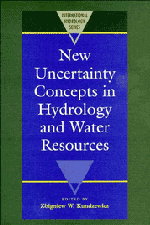Book contents
- Frontmatter
- Contents
- List of Authors
- Preface
- I INTRODUCTION
- II FACETS OF UNCERTAINTY
- III NOVEL APPROACHES TO UNCERTAINTY: FRACTALS, FUZZY SETS AND PATTERN RECOGNITION, NON-PARAMETRIC METHODS
- IV RANDOM FIELDS
- 1 Analysis of regional drought characteristics with empirical orthogonal functions
- 2 Worth of radar data in real-time prediction of mean areal rainfall by nonadvective physically-based models
- 3 Uncertainty analysis in radar-rainfall estimation
- 4 Design of groundwater monitoring networks for landfills
- 5 Spatial variability of evaporation from the land surface – random initial conditions
- 6 Detecting outliers in flood data with geostatistical methods
- V TIME SERIES AND STOCHASTIC PROCESSES
- VI RISK, RELIABILITY AND RELATED CRITERIA
1 - Analysis of regional drought characteristics with empirical orthogonal functions
Published online by Cambridge University Press: 07 May 2010
- Frontmatter
- Contents
- List of Authors
- Preface
- I INTRODUCTION
- II FACETS OF UNCERTAINTY
- III NOVEL APPROACHES TO UNCERTAINTY: FRACTALS, FUZZY SETS AND PATTERN RECOGNITION, NON-PARAMETRIC METHODS
- IV RANDOM FIELDS
- 1 Analysis of regional drought characteristics with empirical orthogonal functions
- 2 Worth of radar data in real-time prediction of mean areal rainfall by nonadvective physically-based models
- 3 Uncertainty analysis in radar-rainfall estimation
- 4 Design of groundwater monitoring networks for landfills
- 5 Spatial variability of evaporation from the land surface – random initial conditions
- 6 Detecting outliers in flood data with geostatistical methods
- V TIME SERIES AND STOCHASTIC PROCESSES
- VI RISK, RELIABILITY AND RELATED CRITERIA
Summary
ABSTRACT An approach to quantify regional meteorological drought is presented. Different definitions and types of drought are discussed and the importance of problem and place related drought criteria is emphasized. The method of empirical orthogonal functions is used for interpolation of drought characteristics: drought area and areal deficit. The method allows quantification of drought characteristics in respect to any chosen drought criteria. The approach is illustrated with one example from Kerala, south-western India.
INTRODUCTION
It is difficult to define precisely what drought is, but in general terms it can be regarded as a condition of ‘lack of sufficient water to meet requirements which are dependent on the distribution of plant, animal and human populations, their lifestyle and their use of the land’ (Gibbs, 1975). It is obvious from this general definition that an universal quantitative measure of drought does not exist. Traditionally three types of drought are distinguished: meteorological, hydrological and agricultural. Meteorological drought can be defined as a prolonged and abnormal moisture deficiency. Hydrological drought can be thought of as a period during which the actual water supply is less than the minimal water supply necessary for normal operation in a particular region. Agricultural drought is usually described in terms of crop failure and is said to exist when soil moisture is depleted so that the yield of plants is reduced considerably (after Thomas, 1965).
As drought (contrary to flood or rainfall) is a ‘non-event’, it is impossible to precisely state the date of its onset or end.
- Type
- Chapter
- Information
- New Uncertainty Concepts in Hydrology and Water Resources , pp. 163 - 167Publisher: Cambridge University PressPrint publication year: 1995
- 2
- Cited by

